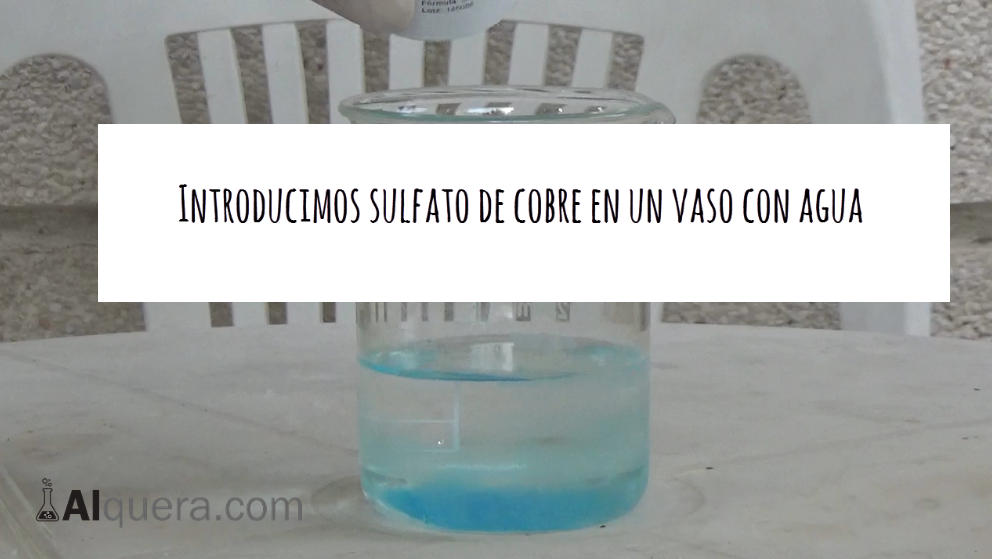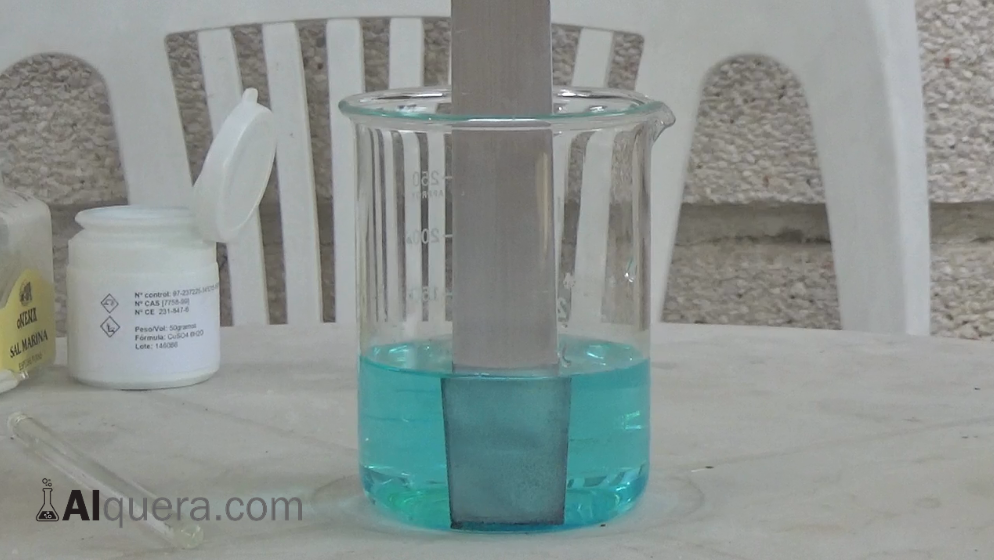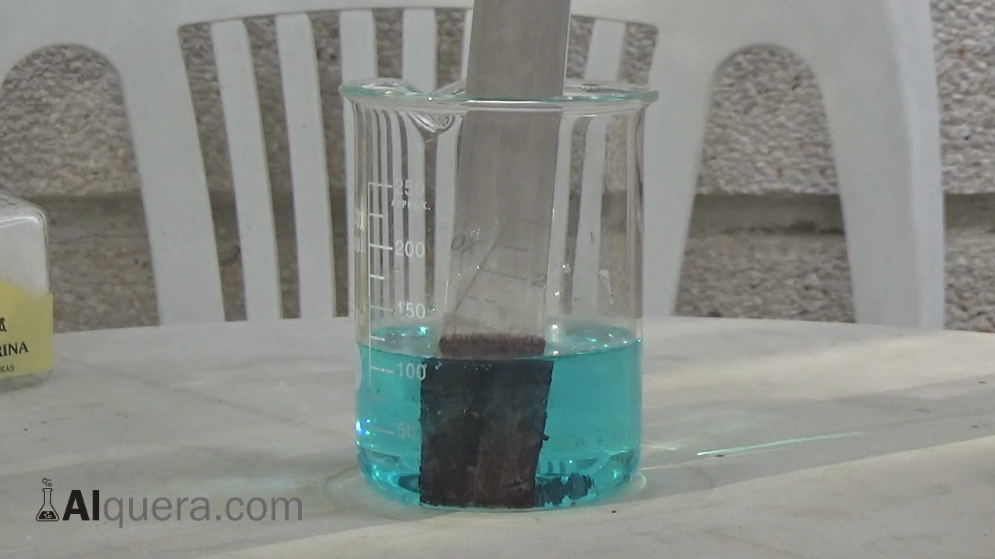COPPER ALUMINIUM SULPHATE REDOX EXPERIMENT SHEET
| Theme | Redox Reaction, Atoms |
| Category | Scientific Experiments, Chemistry Experiments |
| Main products | Copper sulphate |
| Short description | This experiment is very important for 3 fundamental reasons: 1. It is one of the most important reactions in chemistry (oxidation-reduction reaction (Redox)). 2. Through this reaction we are going to achieve the circulation of electrons (the principle of electricity in batteries and cells) and 3. we are going to obtain copper metal from other substances. It is the reaction between copper sulphate in solution and aluminium metal. |
WHAT IS A REDOX REACTION?
A redox reaction, short for reduction-oxidation, is one of the most important chemical reactions occurring in nature, human beings... In redox reactions, electron transfer takes place between a atom and the other, transforming molecules and forming new compounds. In food, now that so much importance is being given to the oxidising, or rather antioxidant, foods, also refer to this type of reaction, where an oxidising element (which is reduced) and a reducing element (which is oxidised) are involved, transforming the elements. The oxidation of metals is also a redox reaction. You can read more about redox reactions here: redox reaction.
In our example, the reaction will be between copper sulphate (in solution in water) and pure aluminium: CuSO4 + Al -> Al2(SO4)3 + Cu. Below, at the end of the experiment, you can see the detail and breakdown of the reaction produced.
MATERIALS FOR THE EXPERIMENT
- Copper Sulphate - We use copper sulphate powder, which we dissolve in water. Approximately 3 tablespoons in a glass of water. You can get copper sulphate at Alquera
- Aluminium - Aluminium sheet available at any hardware store.
- Beaker - (optional) You can use a beaker or any glass container.
- Common salt - Common salt, sodium chloride, will accelerate the transfer of electrons in the liquid. You can use regular salt that you use at home.
STEP-BY-STEP EXPERIMENT
- 1. Place Copper Sulphate in Water in a container.

- 2. Introduce some common salt (sodium chloride) into the solution. The sodium chloride will speed up the reaction as it increases the conductivity of the water, thus promoting the movement of electrons that takes place in the reaction.

- 3. Introduce the aluminium sheet into the solution.

- 4. Wait a few minutes and you will see how the reaction starts to take place, until a reddish layer forms on the aluminium sheet, which corresponds to the copper formed in the reaction. In the following section you can see the reactions and equations that take place until you get to the copper.

TECHNICAL EXPLANATION OF THE EXPERIMENT
Let's look at the redox equations of the reaction. To do this we first look at the oxidation potentials of the components:
Al3+(aq) + 3e- → Al(s) +1.676V
SO42-(aq) + 4H+(aq) + 2e- → 2H2O(l) + SO2(g) -0.17V
Cu2+(aq) + 2e- → Cu(s) - 0.340V
We see that the materials with the greatest potential to enter into oxidation-reduction would be Aluminium (which is oxidised) and Copper (which is reduced). On the other hand, the reaction will take place in an aqueous solution of copper sulphate, which would be sufficient to conduct the electrons to be transferred. To increase the conductivity of the solution we are going to add sodium chloride (common salt), in this way our reaction will be accelerated and we will be able to see the effects more quickly.
The reaction that will therefore take place is:
CuSO4 + Al -> Al2(SO4)3 + Cu
As soon as the aluminium metal is introduced into the copper sulphate solution, a reddish layer starts to form on the aluminium in a few minutes, this is already the reduced copper (copper metal) that is being deposited on the aluminium. If we maintain the reaction over time, the copper will continue to deposit until all the copper in the solution is consumed (or until all the aluminium is consumed, which in this case would not be the case because there is more aluminium than copper sulphate).
MORE EXPERIMENTS
In this section you can see more Scientific Experiments

What kind of reaction is this?
Hi Yuliana! hehe what do you mean? The whole post talks about the reaction. It is oxidation-reduction. If you ask me more in detail, I can answer you better
Sorry, isn't it single scrolling?
hello emmm i would like to know why copper sulphate disintegrates the aluminium foil.
Well that's all the reaction you can read about in the experiment
where this came from:CuSO4 + Al -> Al2(SO4)3 + Cu
Hi! I did this experiment with vinipel and without vinipel, I want to know why it is slower with vinipel.
because if
Interesting reaction... I have been testing ways of soldering aluminium with tin and an electronic soldering iron. By dissolving copper sulphate and ammonium fluoride in water (both 10%) and attacking an aluminium foil with this dilution, I have been able to get the tin to "wet" the aluminium, but it doesn't always work. With silver nitrate instead of copper sulphate it works much better, but silver nitrate is very expensive... I will try adding sodium chloride, maybe I can accelerate the deposition of copper on aluminium and I can get better soldering. If you know any tricks for this, I would like to know about it... Thanks for this post. Sergio.
I made a solar panel out of aluminium foil. When I put the copper sulphate on it, it burnt. Why did it happen? I need to put that substance on it; it's just that the person who made the video did it as it was and didn't have that reaction. Help is a school project.
Good afternoon my daughter is making a solar panel with aluminium foil and as the previous comment says it doesn't work it burns everything, could you tell me what to do so that my daughter can finish her school project.
I'm sorry, can it be done by changing the copper sulphate for sodium sulphate and what does it give?
Does the sodium chloride in this chemical reaction act as a catalyst?
Combustion is a catalyst?
Thank you in advance
Hello sodium chloride facilitates the transport of electrons through the solution, thus facilitating the oxidation-reduction reaction.
How much sodium chloride do you have to add approximately ?
which element is displaced in this reaction?
One question, I am going to leach CuFeS2+HCl. So I will use the product of that reaction instead of a copper sulphate, my question is, can I perform the same experiment and get the same result?
Of what order is this reaction?
Is it heterogeneous or homogeneous?
What is the function of the sodium chloride added to the mixture?
Hello, it increases the speed of the reaction by adding more electrolyte to the water and increasing the conductivity.
speed up the process
What is the function of salt in this experiment?
Hello, speed up the reaction by making it easier for electrons to circulate.
Hello, I have a query.
I had to use Alibour Water for a finger infection. This water contains: copper sulphate CuSO4: 177.0 mg, zinc sulphate ZnSO4: 19.5 mg, camphor: 26.5 mg. I did it in the bathroom and some of it fell into the sink. It smells like a chemical. Is it the copper sulphate on the metal inside the grate? Every time I turn on the faucets and water pours out, I get that smell.
Hello
Copper sulphate itself has quite a metallic smell. Your bathroom plumbing is usually made of steel, and a reaction could be occurring there as well, see https://www.experimentoscientificos.es/reaccion-redox-sulfato-cobre-hierro/ . In any case, the amount of copper sulphate you mention is less than 0.2g (it is very low), wait a couple of days and see if the smell dissolves with water. If not, you would have to look at cleaning with a plunger, either caustic soda or hydrochloric acid, both would cause a reaction in the copper and dissolve it, but you would have to study which would be more efficient.